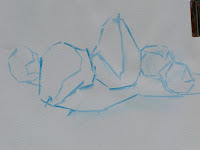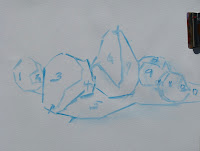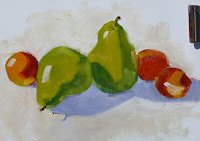
Snow has finally come to Southern Colorado - see last week's post. We got plenty of cold as well - our temps last week went down to 30 below ZERO - which kept my husband from riding his bike to work (zero is his cut off temperature), and definitely kept me out of the landscape. Though the San Luis Valley is at high altitude the surrounding mountain ranges have, so far, kept most of the snow from getting in; but not today. We have been hit with a storm that closed roads into the valley and closed businesses. It is hard to imagine an early Spring in our neck of the woods, no matter what they say in Punxsutauwney.

So last week, the very night our temps hit the basement, I ventured out in the blistering wind and cold to teach an evening class that my husband predicted would be all no shows. He had just ridden in from the afternoon commute.

Thankfully, non of my students ride a bike to class.

So what will induce people to leave a warm hearth and go out when the bottom of the thermometer has dropped out?
I don't know. I do know how much better I feel afterwards.
These four photos follow our class exercise that served 2 good purposes - I like that.
First, seeing SHAPE, and second using MORE paint.
The first sketch shows our little set up of pears and oranges broken down into the SHAPES of form shadows and cast shadows and I encouraged students to squint in order to see only the big shapes, not every nuance of reflected light and shadow. Click on the photos to see them larger.
In the second sketch I have numbered all the shapes. There are 13 in all and after outlining and counting them we mixed paint: one light pile and one dark pile for each color - or in this case, a light and dark for the pears and the same for the oranges - BIG piles. If you are doing this - don't be stingy with the paint.
Photo 3 shows how we used the paint to fill in each of the numbered shapes- in ONE stroke. Yes, you will have to tweedle the brush abit, but it''s fun; thirteen shapes, thirteen strokes.
This encourages discipline in the brushwork and keeps us from making RANDOM strokes; you know, the ones that scream "I'm lost".
In the final photo I have taken the liberty of softening the edges, adding some reflected light and highlights - hopefully, all with the same sense of restraint.
This is a fun exercise. Set up something simple, put a lamp on it and try it for yourself.
And finally- a great quote: "When you go out to paint try to forget what object you have before you - a tree, a house, a field or whatever. Merely think, here is a little square of blue, here an oblong of pink, here a streak of yellow, and paint it just as it looks to you, the exact colour and shape, until it emerges as your own naive impression of the scene before you." Claude Monet.